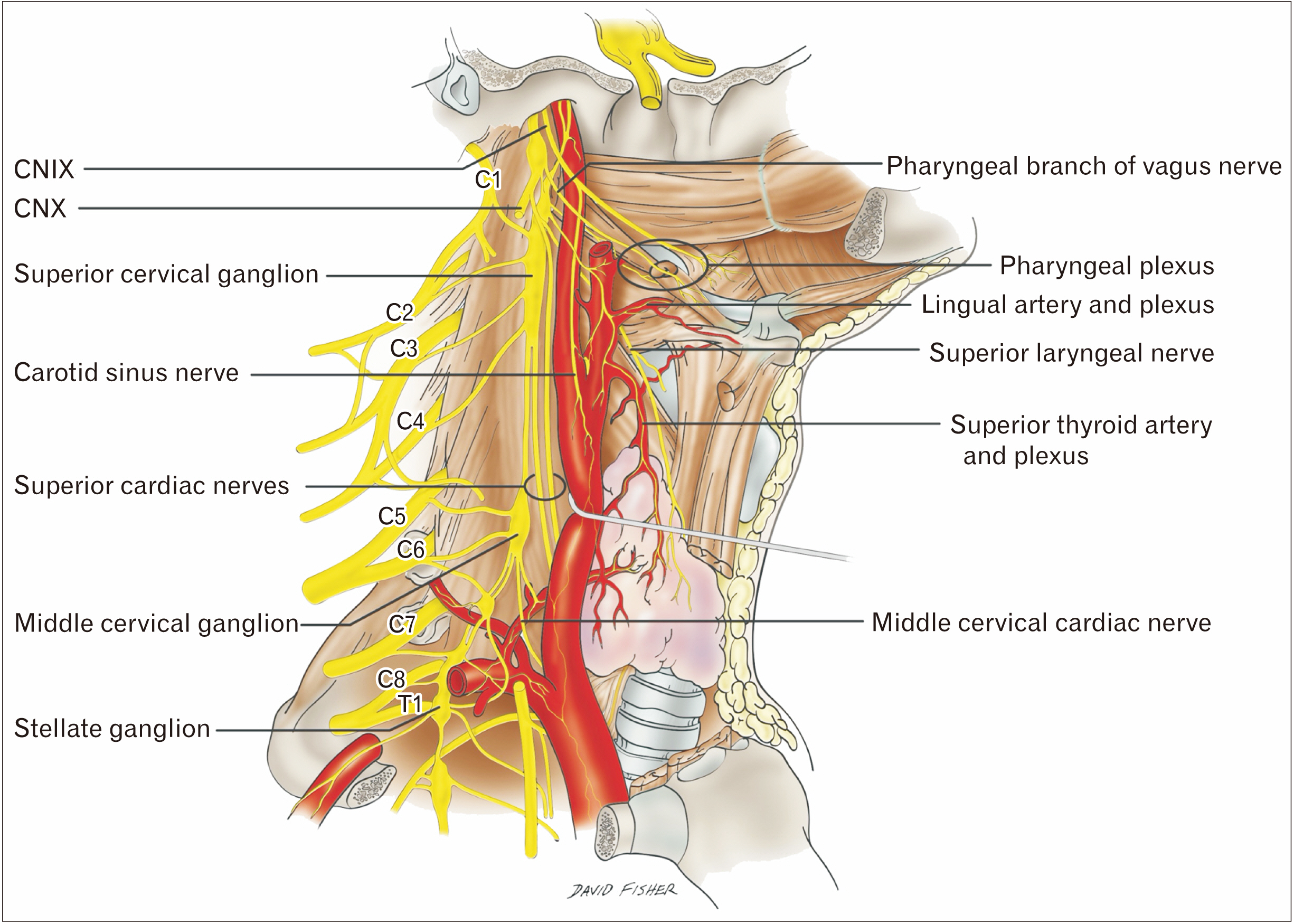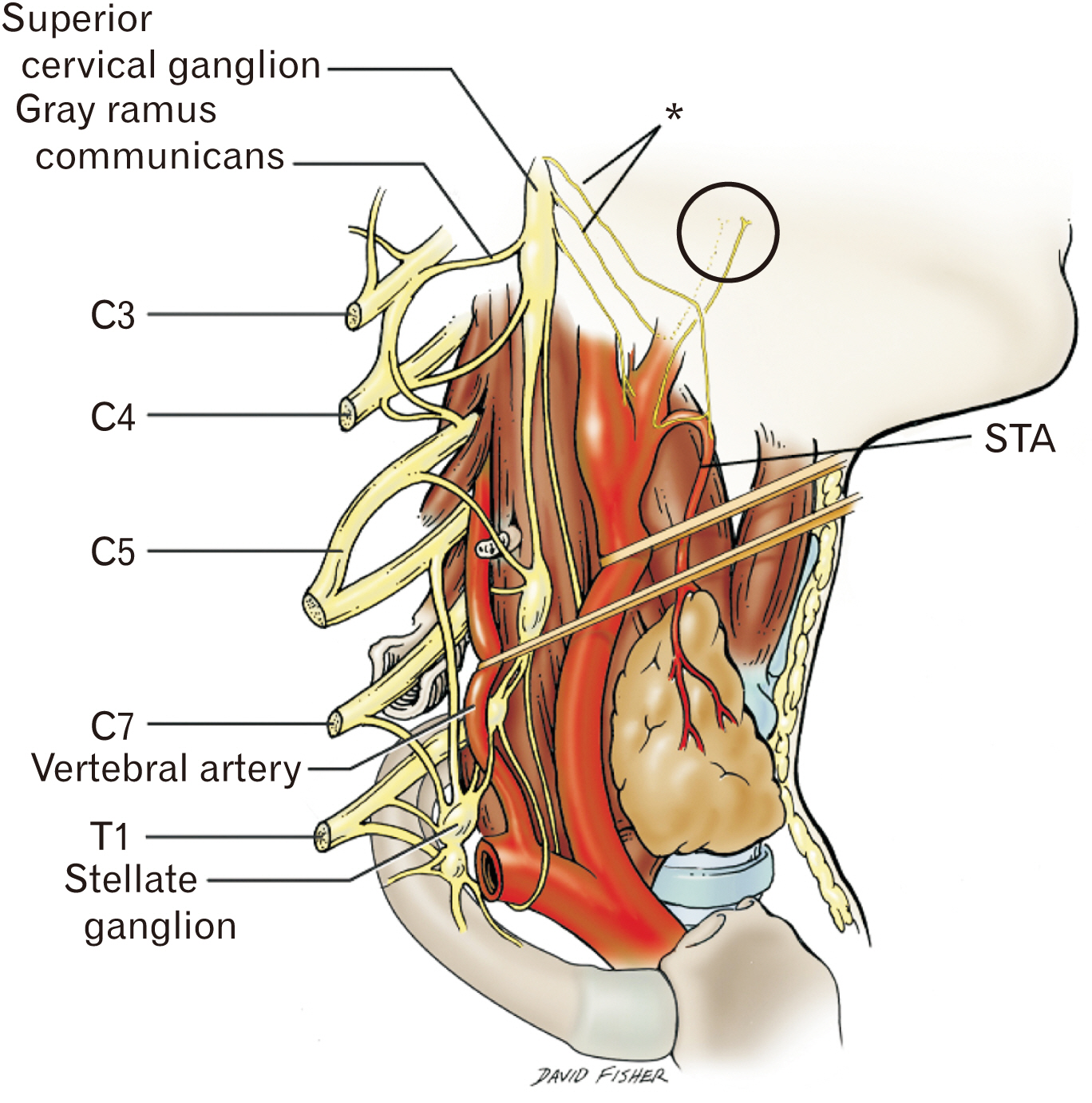Anat Cell Biol.
2021 Jun;54(2):137-142. 10.5115/acb.20.308.
Review of the external carotid plexus: anatomy, function, and clinical manifestations
- Affiliations
-
- 1Department of Structural & Cellular Biology, Tulane University School of Medicine, New Orleans, LA, USA
- 2Department of General & Vascular Surgery, Shahid Beheshti University of Medical Sciences, Tehran, Iran
- 3Department of Neurosurgery, Tulane Center for Clinical Neurosciences, Tulane University School of Medicine, New Orleans, LA, USA
- 4Department of Neurology, Tulane Center for Clinical Neurosciences, Tulane University School of Medicine, New Orleans, LA, USA
- 5Department of Neurosurgery and Ochsner Neuroscience Institute, Ochsner Health System, New Orleans, LA, USA
- 6Department of Anatomical Sciences, St. George’s University, St. George’s, Grenada, West Indies
- KMID: 2516897
- DOI: http://doi.org/10.5115/acb.20.308
Abstract
- The external carotid plexus is a combination of postganglionic sympathetic fibers derived from the superior cervical ganglion. This plexus travels along the external carotid artery and continues onto the artery’s branches. The external carotid plexus plays an important role in innervating the mid and lower face. Therefore, implications to the plexus may result in facial abnormalities. Herein, we review the anatomy, function, and review its clinical applications.
Keyword
Figure
Cited by 1 articles
-
The laryngopharyngeal nerve: a comprehensive review
Stephen Shapiro, Andrew L. Parker, Juan J. Cardona, Arada Chaiyamoon, Francisco Reina, Ana Carrera, Joe Iwanaga, Aaron S. Dumont, R. Shane Tubbs
Anat Cell Biol. 2023;56(3):299-303. doi: 10.5115/acb.22.254.
Reference
-
References
1. Drummond PD. 2006; Mechanisms of autonomic disturbance in the face during and between attacks of cluster headache. Cephalalgia. 26:633–41. DOI: 10.1111/j.1468-2982.2006.01106.x. PMID: 16686902.2. Gardner E. 1943; Surgical anatomy of the external carotid plexus. Arch Surg. 46:238–44. DOI: 10.1001/archsurg.1943.01220080074006.
Article3. Purnyn H, Rikhalsky O, Fedulova S, Veselovsky N. 2007; Transmission pathways in the rat superior cervical ganglion. Neurophysiology. 39:347–9. DOI: 10.1007/s11062-007-0053-2.
Article4. Mitsuoka K, Kikutani T, Sato I. 2016; Morphological relationship between the superior cervical ganglion and cervical nerves in Japanese cadaver donors. Brain Behav. 7:e00619. DOI: 10.1002/brb3.619. PMID: 28239529. PMCID: PMC5318372.
Article5. Roesch ZK, Tadi P. 2020. Anatomy, head and neck, neck. StatPearls Publishing;Treasure Island:6. Tubbs RS, Rizk E, Shoja MM, Loukas M, Barbaro N, Spinner RJ. 2015. Nerves and nerve injuries. Volume1: history, embryology, anatomy, imaging, and diagnosis. Elsevier;London:7. Morris H, Anson BJ. 1966. Human anatomy: a complete systematic treatise. 12th ed. Blakiston Division, McGraw-Hill;New York: p. 1036.8. Zubair A, Khan YS. 2021. Neuroanatomy, otic ganglion. StatPearls Publishing;Treasure Island:9. Irwin PA, Tubbs RI, Tubbs RS. Tubbs RS, Shoja MM, Loukas M, editors. 2016. Autonomic nervous system. Bergman's Comprehensive Encyclopedia of Human Anatomic Variation. John Wiley & Sons;Hoboken: p. 1050–6. DOI: 10.1002/9781118430309.ch88. PMID: 27326756.
Article10. Arakawa T, Terashima T, Banneheka S, Tokita K, Fukazawa M, Suzuki R, Miyawaki M, Chiba S, Kumaki K, Miki A. 2008; Nerve communication between the glossopharyngeal nerve, external carotid plexus and the superficial cervical ansa: human autopsy case. Anat Sci Int. 83:112–9. DOI: 10.1111/j.1447-073X.2007.00183.x. PMID: 18507621.
Article11. Abe S, Fukuda M, Yamane S, Saka H, Katori Y, Rodríguez-Vázquez JF, Murakami G. 2013; Fetal anatomy of the upper pharyngeal muscles with special reference to the nerve supply: is it an enteric plexus or simply an intramuscular nerve? Anat Cell Biol. 46:141–8. DOI: 10.5115/acb.2013.46.2.141. PMID: 23869261. PMCID: PMC3713278.
Article12. Shao BP, Ding YP, Xie ZH, Yu HX, Brand-Saberi B, Wang JL. 2007; The cranial cervical ganglion and its branches in the yak (Bos grunniens). Vet J. 173:174–7. DOI: 10.1016/j.tvjl.2005.08.016. PMID: 16246603.
Article13. Rusu MC, Pop F. 2010; The anatomy of the sympathetic pathway through the pterygopalatine fossa in humans. Ann Anat. 192:17–22. DOI: 10.1016/j.aanat.2009.10.003. PMID: 19939656.
Article14. Goudihalli SR, Goto T, Bohoun C, Nagahama A, Tanoue Y, Morisako H, Kawahara S, Ohata K. 2018; Sympathetic plexus schwannoma of carotid canal: 2 cases with surgical technique and review of literature. World Neurosurg. 118:63–8. DOI: 10.1016/j.wneu.2018.06.244. PMID: 30004012.
Article15. Salvesen R. 2001; Innervation of sweat glands in the forehead. A study in patients with Horner,s syndrome. J Neurol Sci. 183:39–42. DOI: 10.1016/S0022-510X(00)00479-2.
Article16. Tao MJ, Roche-Nagle G. 2016; First bite syndrome: a complication of carotid endarterectomy. BMJ Case Rep. 2016:bcr2015213996. DOI: 10.1136/bcr-2015-213996. PMID: 26994046. PMCID: PMC4800229.
Article17. Fazliogullari Z, Kilic C, Karabulut AK, Yazar F. 2016; A morphometric analysis of the superior cervical ganglion and its surrounding structures. Surg Radiol Anat. 38:299–302. DOI: 10.1007/s00276-015-1551-3. PMID: 26364034.
Article18. Turco GR, Farber NE. 1996; Postoperative autonomic deficit: a case of harlequin syndrome. Anesthesiology. 85:1197–9. DOI: 10.1097/00000542-199611000-00031. PMID: 8916840.19. Karkos CD, Fearn SJ, McCollum CN. 2000; External carotid surgery. Vasc Surg. 34:303–8. DOI: 10.1177/153857440003400404.
Article20. Gertler JP, Cambria RP. 1987; The role of external carotid endarterectomy in the treatment of ipsilateral internal carotid occlusion: collective review. J Vasc Surg. 6:158–67. DOI: 10.1067/mva.1987.avs0060158. PMID: 3302317.
Article21. Michalinos A, Chatzimarkos M, Arkadopoulos N, Safioleas M, Troupis T. 2016; Anatomical considerations on surgical anatomy of the carotid bifurcation. Anat Res Int. 2016:6907472. DOI: 10.1155/2016/6907472. PMID: 27047690. PMCID: PMC4800075.
Article22. Koziej M, Polak J, Wnuk J, Trybus M, Walocha J, Chrapusta A, Brzegowy P, Mizia E, Popiela T, Hołda M. 2019; The transverse facial artery anatomy: implications for plastic surgery procedures. PLoS One. 14:e0211974. DOI: 10.1371/journal.pone.0211974. PMID: 30730953. PMCID: PMC6366864.
Article
- Full Text Links
- Actions
-
Cited
- CITED
-
- Close
- Share
- Similar articles
-
- The laryngopharyngeal nerve: a comprehensive review
- Anesthetic Management of Carotid Endarterectomy under Cervical Plexus Block
- A cadaveric study on variations in branching pattern of external carotid artery
- Bilateral thyrolinguofacial trunk: unusual and rare branching pattern of external carotid artery
- Collateral Circulation on the Neck after Common Carotid Ligation(Bosniak's Plexus)



